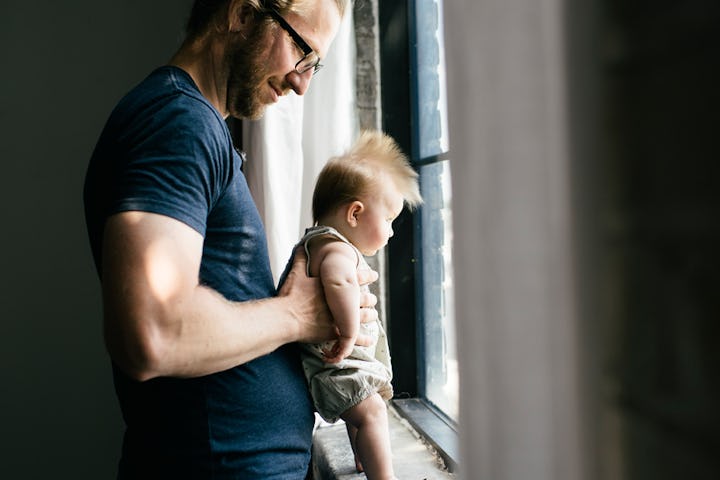What Swedish Dads and Nordic Dads Have That We Don’t
A new survey about the state of paternity leave among Nordic dads confirms their place at the front of the pack of modern, involved dads.

In the 1970s and 80s, when Nordic countries first introduced shared parental leave, it was rare to see a father take advantage of it. Staying at home with kids was viewed as women’s work; men who did so were viewed as unmanly. In Sweden, those who did stay at home were called “velour dads,” a slang term for men who dressed in pajamas.
A few decades later, Nordic dads, proudly pajama-clad, have become shining examples of involved fathers. Swedish dads, in particular, are lovingly known as “lattes pappas” — a term synonymous with a hip young father seen sipping small coffees and munching on baked goods (fika) while supporting a sleeping kid strapped to their chest. The mythos mostly holds up: A survey about the state of paternity leave among Nordic dads confirms their place at the front of the pack of modern, involved dads. But it also reveals that they have work to do in terms of fully embracing their roles.
Conducted by Promundo, the “State of Nordic Fathers” report is based on a survey of 7515 people, evenly distributed between Sweden, Denmark, Iceland, Finland, and Norway. It was done in partnership with Promundo’s 2019 “State of the World’s Fathers”, a massive report on fathers from 40 countries about fatherhood, gender identity, and paternity leave, and contains responses from more than 3,099 fathers and 1,646 mothers. The aim of the survey was to compare the attitudes and opinions of parents who took different lengths of leave.
Views on leave have certainly shifted since the 70s and 80s. Parents in Nordic countries, according to the survey, believe that parental leave is no longer for mothers only, with 75 percent of both men and women saying it should be split down the middle between parents. Nordic men are also psyched to be involved in parenting. Between 89 percent (in Denmark) and 96 percent (in Sweden) of fathers not only said they felt capable of being caregivers but also want to be very active in the early months and years of their children’s lives. Between 86 and 94 percent of all parents surveyed also agreed that it’s a father’s responsibility to be heavily involved in childcare.
Why? Men know that playing the role of caregivers pays off. The report confirms the fact that men who take lengthy paternity leave (all countries allow 40 weeks or more of leave, with Sweden offering the longest at 69 weeks) have better relationships with their partners and children as well as greater life satisfaction overall. Fathers who took longer paternity leave are also less likely to adhere to traditional norms of masculinity, less likely to rely on a female partner, and more likely to seek out information on childcare from such sources as parenting books and doctors. To men living in Nordic countries, all of which have had decades of social networks that protect fatherhood, these benefits are well known.
That’s not to say everyone is taking advantage. There’s one failing that Nordic dads share with the rest of the world: They don’t take their paternity leave. “Finnish fathers on average take only 11 percent of the paid paternity leave they are entitled to after the birth of a child,” the report states. “While the figure is close to the same in Denmark, in Norway it is around 20 percent and in Sweden and Iceland nearly 30 percent.” Conversely, nearly 80 percent of moms took more than six months of leave, compared to roughly five percent of fathers.
What gives? Well, the survey shows that a lot of men who didn’t take paternity leave do so because they thought it would negatively impact their careers and relationships with co-workers. Those who said they had more understanding managers, however, were more likely to take additional leave.
Furthermore, gender roles still have a long way to come. Mothers in the survey were much more likely to say that dads should be very involved with childcare, planning, arranging playdates, etc. (85 percent of Swedish moms said as much). And almost all mothers and fathers in the survey agreed that both the father and the mother to be heavily involved in all three forms of childcare.
When it comes to household equality, however, there’s a difference in perception versus reality. While 55 percent of fathers say they share daily planning equally, only 33 percent of mothers agree, saying instead that they either do most or all of the work (64 percent). Between 66 and 70 percent of fathers said they share physical and emotional care equally with their partners, where only half of moms say it’s an equal split.
Of course, this is just a failing in a vacuum. Compared to the rest of the world, Nordic dads are miles ahead. In the U.S., for example, men have certainly increased the amount of time they spend on housework and caring for family members in recent decades, but women still do roughly twice as much around the house.
So, while the Nordic countries do deserve their forward-thinking approach to parental leave and fathers are committed to be excellent caretakers, no place is perfect. Some men are unwilling to take leave if it compromises their standing and are also more likely to overestimate how much they pitch in around the house. Even with the padding they’re provided, Nordic dads have some work to do. Just not as much as the rest of us.
This article was originally published on